6-1,构建模型的3种方法#
可以使用以下3种方式构建模型:使用Sequential按层顺序构建模型,使用函数式API构建任意结构模型,继承Model基类构建自定义模型。
对于顺序结构的模型,优先使用Sequential方法构建。
如果模型有多输入或者多输出,或者模型需要共享权重,或者模型具有残差连接等非顺序结构,推荐使用函数式API进行创建。
如果无特定必要,尽可能避免使用Model子类化的方式构建模型,这种方式提供了极大的灵活性,但也有更大的概率出错。
下面以IMDB电影评论的分类问题为例,演示3种创建模型的方法。
import numpy as np
import pandas as pd
import tensorflow as tf
from tqdm import tqdm
from tensorflow.keras import *
train_token_path = "../../data/imdb/train_token.csv"
test_token_path = "../../data/imdb/test_token.csv"
MAX_WORDS = 10000 # We will only consider the top 10,000 words in the dataset
MAX_LEN = 200 # We will cut reviews after 200 words
BATCH_SIZE = 20
# 构建管道
def parse_line(line):
t = tf.strings.split(line,"\t")
label = tf.reshape(tf.cast(tf.strings.to_number(t[0]),tf.int32),(-1,))
features = tf.cast(tf.strings.to_number(tf.strings.split(t[1]," ")),tf.int32)
return (features,label)
ds_train= tf.data.TextLineDataset(filenames = [train_token_path]) \
.map(parse_line,num_parallel_calls = tf.data.experimental.AUTOTUNE) \
.shuffle(buffer_size = 1000).batch(BATCH_SIZE) \
.prefetch(tf.data.experimental.AUTOTUNE)
ds_test= tf.data.TextLineDataset(filenames = [test_token_path]) \
.map(parse_line,num_parallel_calls = tf.data.experimental.AUTOTUNE) \
.shuffle(buffer_size = 1000).batch(BATCH_SIZE) \
.prefetch(tf.data.experimental.AUTOTUNE)
一,Sequential按层顺序创建模型#
tf.keras.backend.clear_session()
model = models.Sequential()
model.add(layers.Embedding(MAX_WORDS,7,input_length=MAX_LEN))
model.add(layers.Conv1D(filters = 64,kernel_size = 5,activation = "relu"))
model.add(layers.MaxPool1D(2))
model.add(layers.Conv1D(filters = 32,kernel_size = 3,activation = "relu"))
model.add(layers.MaxPool1D(2))
model.add(layers.Flatten())
model.add(layers.Dense(1,activation = "sigmoid"))
model.compile(optimizer='Nadam',
loss='binary_crossentropy',
metrics=['accuracy',"AUC"])
model.summary()
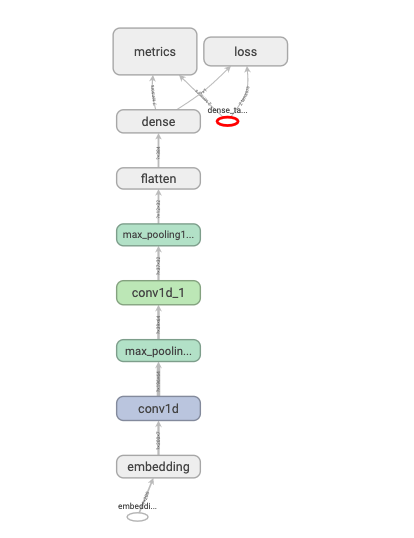
import datetime
baselogger = callbacks.BaseLogger(stateful_metrics=["AUC"])
logdir = "../../data/keras_model/" + datetime.datetime.now().strftime("%Y%m%d-%H%M%S")
tensorboard_callback = tf.keras.callbacks.TensorBoard(logdir, histogram_freq=1)
history = model.fit(ds_train,validation_data = ds_test,
epochs = 6,callbacks=[baselogger,tensorboard_callback])
%matplotlib inline
%config InlineBackend.figure_format = 'svg'
import matplotlib.pyplot as plt
def plot_metric(history, metric):
train_metrics = history.history[metric]
val_metrics = history.history['val_'+metric]
epochs = range(1, len(train_metrics) + 1)
plt.plot(epochs, train_metrics, 'bo--')
plt.plot(epochs, val_metrics, 'ro-')
plt.title('Training and validation '+ metric)
plt.xlabel("Epochs")
plt.ylabel(metric)
plt.legend(["train_"+metric, 'val_'+metric])
plt.show()
plot_metric(history,"AUC")
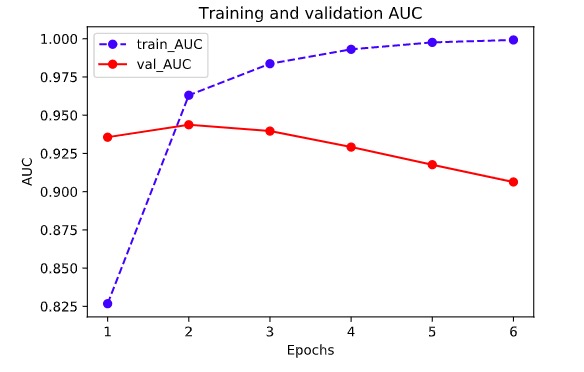
二,函数式API创建任意结构模型#
tf.keras.backend.clear_session()
inputs = layers.Input(shape=[MAX_LEN])
x = layers.Embedding(MAX_WORDS,7)(inputs)
branch1 = layers.SeparableConv1D(64,3,activation="relu")(x)
branch1 = layers.MaxPool1D(3)(branch1)
branch1 = layers.SeparableConv1D(32,3,activation="relu")(branch1)
branch1 = layers.GlobalMaxPool1D()(branch1)
branch2 = layers.SeparableConv1D(64,5,activation="relu")(x)
branch2 = layers.MaxPool1D(5)(branch2)
branch2 = layers.SeparableConv1D(32,5,activation="relu")(branch2)
branch2 = layers.GlobalMaxPool1D()(branch2)
branch3 = layers.SeparableConv1D(64,7,activation="relu")(x)
branch3 = layers.MaxPool1D(7)(branch3)
branch3 = layers.SeparableConv1D(32,7,activation="relu")(branch3)
branch3 = layers.GlobalMaxPool1D()(branch3)
concat = layers.Concatenate()([branch1,branch2,branch3])
outputs = layers.Dense(1,activation = "sigmoid")(concat)
model = models.Model(inputs = inputs,outputs = outputs)
model.compile(optimizer='Nadam',
loss='binary_crossentropy',
metrics=['accuracy',"AUC"])
model.summary()
Model: "model"
__________________________________________________________________________________________________
Layer (type) Output Shape Param # Connected to
==================================================================================================
input_1 (InputLayer) [(None, 200)] 0
__________________________________________________________________________________________________
embedding (Embedding) (None, 200, 7) 70000 input_1[0][0]
__________________________________________________________________________________________________
separable_conv1d (SeparableConv (None, 198, 64) 533 embedding[0][0]
__________________________________________________________________________________________________
separable_conv1d_2 (SeparableCo (None, 196, 64) 547 embedding[0][0]
__________________________________________________________________________________________________
separable_conv1d_4 (SeparableCo (None, 194, 64) 561 embedding[0][0]
__________________________________________________________________________________________________
max_pooling1d (MaxPooling1D) (None, 66, 64) 0 separable_conv1d[0][0]
__________________________________________________________________________________________________
max_pooling1d_1 (MaxPooling1D) (None, 39, 64) 0 separable_conv1d_2[0][0]
__________________________________________________________________________________________________
max_pooling1d_2 (MaxPooling1D) (None, 27, 64) 0 separable_conv1d_4[0][0]
__________________________________________________________________________________________________
separable_conv1d_1 (SeparableCo (None, 64, 32) 2272 max_pooling1d[0][0]
__________________________________________________________________________________________________
separable_conv1d_3 (SeparableCo (None, 35, 32) 2400 max_pooling1d_1[0][0]
__________________________________________________________________________________________________
separable_conv1d_5 (SeparableCo (None, 21, 32) 2528 max_pooling1d_2[0][0]
__________________________________________________________________________________________________
global_max_pooling1d (GlobalMax (None, 32) 0 separable_conv1d_1[0][0]
__________________________________________________________________________________________________
global_max_pooling1d_1 (GlobalM (None, 32) 0 separable_conv1d_3[0][0]
__________________________________________________________________________________________________
global_max_pooling1d_2 (GlobalM (None, 32) 0 separable_conv1d_5[0][0]
__________________________________________________________________________________________________
concatenate (Concatenate) (None, 96) 0 global_max_pooling1d[0][0]
global_max_pooling1d_1[0][0]
global_max_pooling1d_2[0][0]
__________________________________________________________________________________________________
dense (Dense) (None, 1) 97 concatenate[0][0]
==================================================================================================
Total params: 78,938
Trainable params: 78,938
Non-trainable params: 0
__________________________________________________________________________________________________
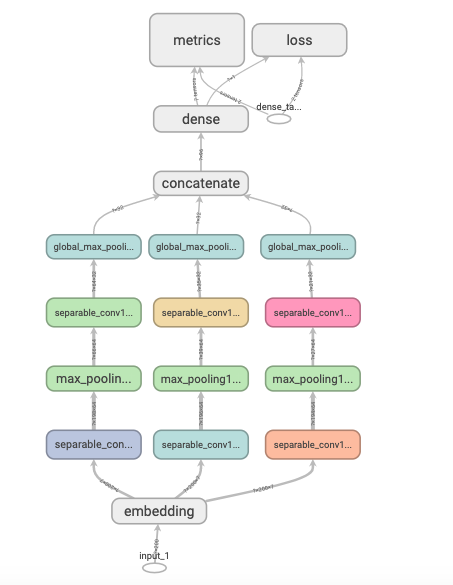
import datetime
logdir = "../../data/keras_model/" + datetime.datetime.now().strftime("%Y%m%d-%H%M%S")
tensorboard_callback = tf.keras.callbacks.TensorBoard(logdir, histogram_freq=1)
history = model.fit(ds_train,validation_data = ds_test,epochs = 6,callbacks=[tensorboard_callback])
Epoch 1/6
1000/1000 [==============================] - 32s 32ms/step - loss: 0.5527 - accuracy: 0.6758 - AUC: 0.7731 - val_loss: 0.3646 - val_accuracy: 0.8426 - val_AUC: 0.9192
Epoch 2/6
1000/1000 [==============================] - 24s 24ms/step - loss: 0.3024 - accuracy: 0.8737 - AUC: 0.9444 - val_loss: 0.3281 - val_accuracy: 0.8644 - val_AUC: 0.9350
Epoch 3/6
1000/1000 [==============================] - 24s 24ms/step - loss: 0.2158 - accuracy: 0.9159 - AUC: 0.9715 - val_loss: 0.3461 - val_accuracy: 0.8666 - val_AUC: 0.9363
Epoch 4/6
1000/1000 [==============================] - 24s 24ms/step - loss: 0.1492 - accuracy: 0.9464 - AUC: 0.9859 - val_loss: 0.4017 - val_accuracy: 0.8568 - val_AUC: 0.9311
Epoch 5/6
1000/1000 [==============================] - 24s 24ms/step - loss: 0.0944 - accuracy: 0.9696 - AUC: 0.9939 - val_loss: 0.4998 - val_accuracy: 0.8550 - val_AUC: 0.9233
Epoch 6/6
1000/1000 [==============================] - 26s 26ms/step - loss: 0.0526 - accuracy: 0.9865 - AUC: 0.9977 - val_loss: 0.6463 - val_accuracy: 0.8462 - val_AUC: 0.9138
plot_metric(history,"AUC")
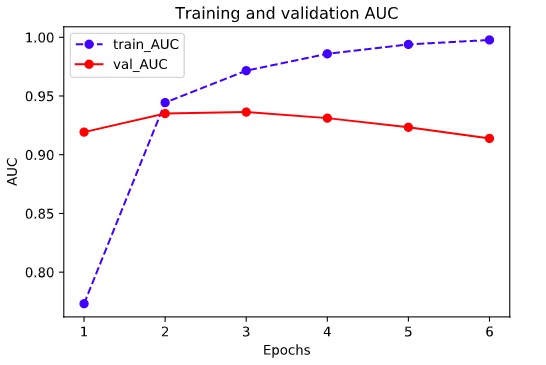
三,Model子类化创建自定义模型#
# 先自定义一个残差模块,为自定义Layer
class ResBlock(layers.Layer):
def __init__(self, kernel_size, **kwargs):
super(ResBlock, self).__init__(**kwargs)
self.kernel_size = kernel_size
def build(self,input_shape):
self.conv1 = layers.Conv1D(filters=64,kernel_size=self.kernel_size,
activation = "relu",padding="same")
self.conv2 = layers.Conv1D(filters=32,kernel_size=self.kernel_size,
activation = "relu",padding="same")
self.conv3 = layers.Conv1D(filters=input_shape[-1],
kernel_size=self.kernel_size,activation = "relu",padding="same")
self.maxpool = layers.MaxPool1D(2)
super(ResBlock,self).build(input_shape) # 相当于设置self.built = True
def call(self, inputs):
x = self.conv1(inputs)
x = self.conv2(x)
x = self.conv3(x)
x = layers.Add()([inputs,x])
x = self.maxpool(x)
return x
#如果要让自定义的Layer通过Functional API 组合成模型时可以序列化,需要自定义get_config方法。
def get_config(self):
config = super(ResBlock, self).get_config()
config.update({'kernel_size': self.kernel_size})
return config
# 测试ResBlock
resblock = ResBlock(kernel_size = 3)
resblock.build(input_shape = (None,200,7))
resblock.compute_output_shape(input_shape=(None,200,7))
TensorShape([None, 100, 7])
# 自定义模型,实际上也可以使用Sequential或者FunctionalAPI
class ImdbModel(models.Model):
def __init__(self):
super(ImdbModel, self).__init__()
def build(self,input_shape):
self.embedding = layers.Embedding(MAX_WORDS,7)
self.block1 = ResBlock(7)
self.block2 = ResBlock(5)
self.dense = layers.Dense(1,activation = "sigmoid")
super(ImdbModel,self).build(input_shape)
def call(self, x):
x = self.embedding(x)
x = self.block1(x)
x = self.block2(x)
x = layers.Flatten()(x)
x = self.dense(x)
return(x)
tf.keras.backend.clear_session()
model = ImdbModel()
model.build(input_shape =(None,200))
model.summary()
model.compile(optimizer='Nadam',
loss='binary_crossentropy',
metrics=['accuracy',"AUC"])
Model: "imdb_model"
_________________________________________________________________
Layer (type) Output Shape Param #
=================================================================
embedding (Embedding) multiple 70000
_________________________________________________________________
res_block (ResBlock) multiple 19143
_________________________________________________________________
res_block_1 (ResBlock) multiple 13703
_________________________________________________________________
dense (Dense) multiple 351
=================================================================
Total params: 103,197
Trainable params: 103,197
Non-trainable params: 0
_________________________________________________________________
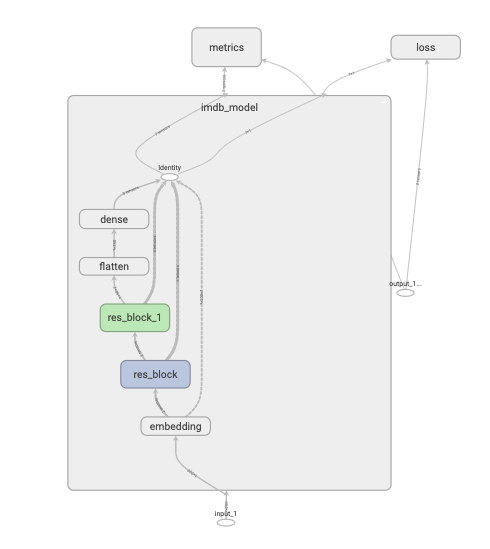
import datetime
logdir = "./tflogs/keras_model/" + datetime.datetime.now().strftime("%Y%m%d-%H%M%S")
tensorboard_callback = tf.keras.callbacks.TensorBoard(logdir, histogram_freq=1)
history = model.fit(ds_train,validation_data = ds_test,
epochs = 6,callbacks=[tensorboard_callback])
Epoch 1/6
1000/1000 [==============================] - 47s 47ms/step - loss: 0.5629 - accuracy: 0.6618 - AUC: 0.7548 - val_loss: 0.3422 - val_accuracy: 0.8510 - val_AUC: 0.9286
Epoch 2/6
1000/1000 [==============================] - 43s 43ms/step - loss: 0.2648 - accuracy: 0.8903 - AUC: 0.9576 - val_loss: 0.3276 - val_accuracy: 0.8650 - val_AUC: 0.9410
Epoch 3/6
1000/1000 [==============================] - 42s 42ms/step - loss: 0.1573 - accuracy: 0.9439 - AUC: 0.9846 - val_loss: 0.3861 - val_accuracy: 0.8682 - val_AUC: 0.9390
Epoch 4/6
1000/1000 [==============================] - 42s 42ms/step - loss: 0.0849 - accuracy: 0.9706 - AUC: 0.9950 - val_loss: 0.5324 - val_accuracy: 0.8616 - val_AUC: 0.9292
Epoch 5/6
1000/1000 [==============================] - 43s 43ms/step - loss: 0.0393 - accuracy: 0.9876 - AUC: 0.9986 - val_loss: 0.7693 - val_accuracy: 0.8566 - val_AUC: 0.9132
Epoch 6/6
1000/1000 [==============================] - 44s 44ms/step - loss: 0.0222 - accuracy: 0.9926 - AUC: 0.9994 - val_loss: 0.9328 - val_accuracy: 0.8584 - val_AUC: 0.9052
plot_metric(history,"AUC")
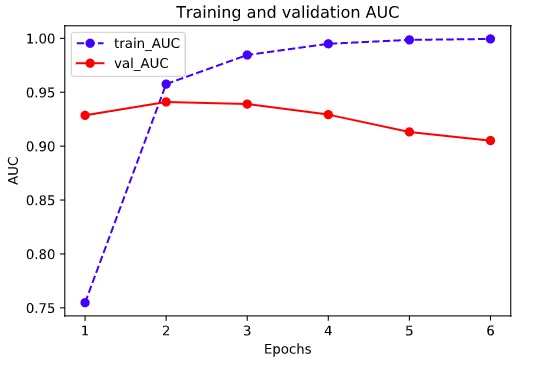
如果对本书内容理解上有需要进一步和作者交流的地方,欢迎在公众号"Python与算法之美"下留言。作者时间和精力有限,会酌情予以回复。
也可以在公众号后台回复关键字:加群,加入读者交流群和大家讨论。
